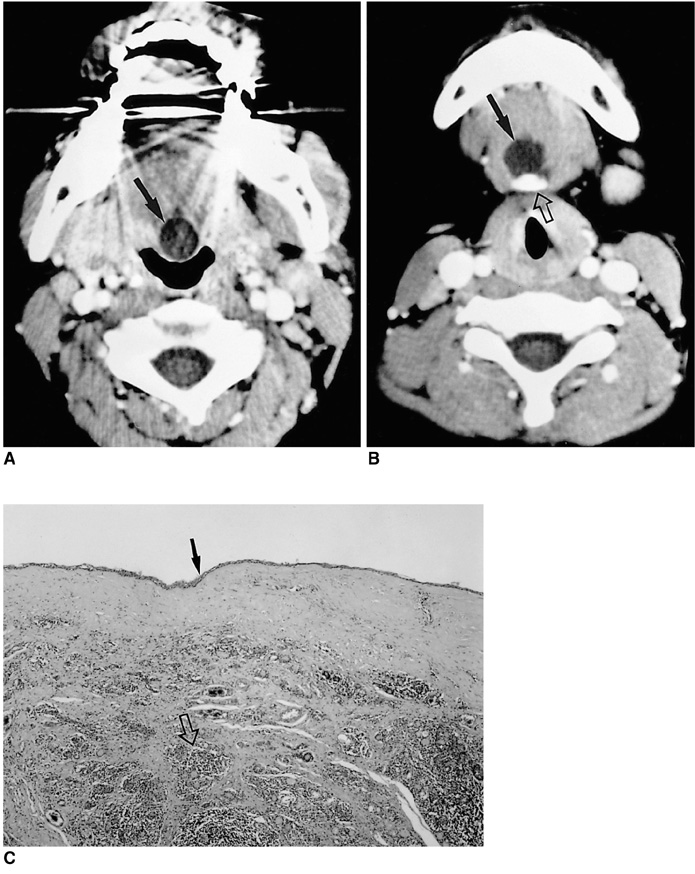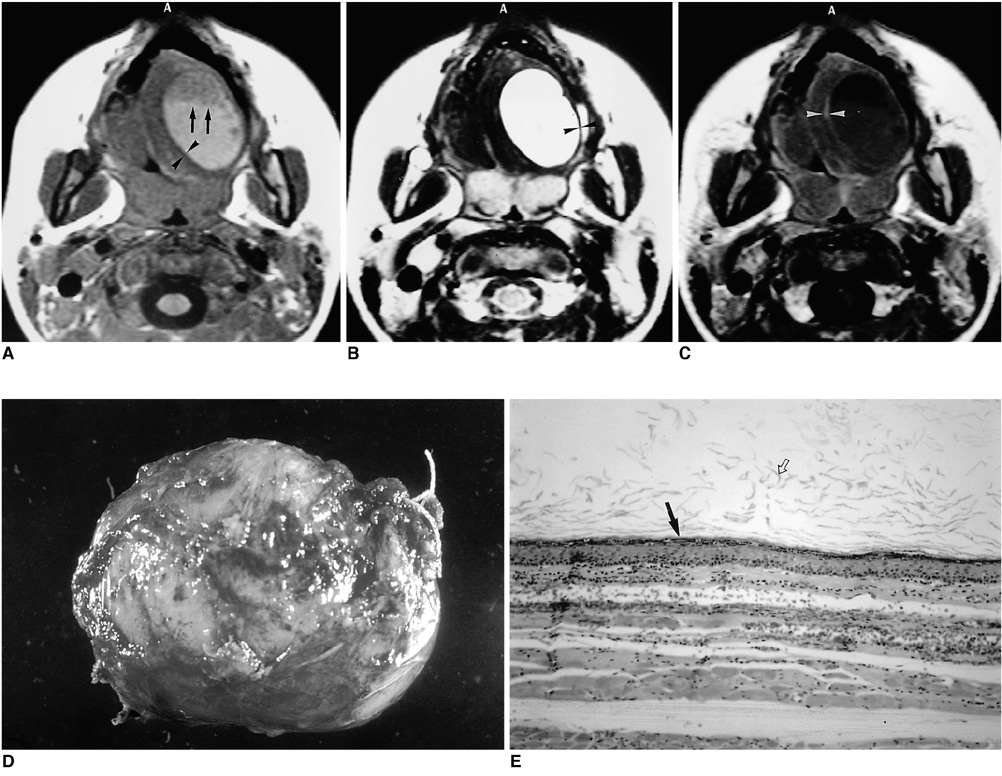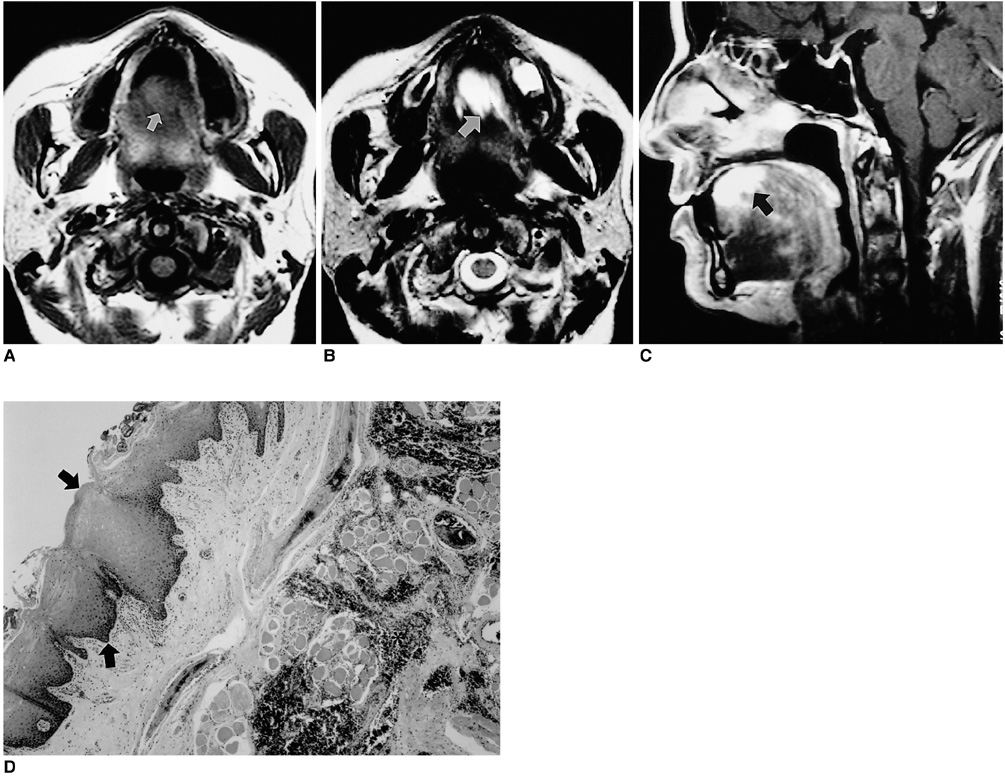Korean J Radiol.
2001 Mar;2(1):37-41. 10.3348/kjr.2001.2.1.37.
Radiologic-Pathologic Correlation of Unusual Lingual Masses:Part I: Congenital Lesions
- Affiliations
-
- 1Seoul Natl Univ Hosp,Dept Diagnost Radiol Chongno Gu,28 Yongon Dong, Seoul 110744, South Korea.
- KMID: 754121
- DOI: http://doi.org/10.3348/kjr.2001.2.1.37
Abstract
- Because the tongue is superficially located and the intial manifestation of most diseases occurring there is mucosal change, lingual these lesions can be easily accessed and diagnosed without imaging analysis. Most congenital lesions of the tongue, however, can manifest as a submucosal bulge and be located in a deep portion of that organ such as its base; their true characteristics and extent may be recognized only on cross-sectional images such as those obtained by CT or MRI. In addition, because it is usually difficult to differentiate congenital lesions from other submucosal neoplasms on the basis of imaging findings alone, clinical history and physical examination should always be taken into consideration when interpretating CT and MR images of the tongue. Although the radiologic findings for congenital lesions are nonspecific, CT and MR imaging can play an important role in the diagnostic work-up of these unusual lesions. Delineation of the extent of the tumor, and recognition and understanding of the spectrum of imaging and the pathologic features of these lesions, often help narrow the differential diagnosis.
Keyword
MeSH Terms
Figure
Cited by 1 articles
-
Congenital Epidermoid Cyst of the Oral Cavity: Prenatal Diagnosis by Sonography
Seung Wan Park, Jung Ju Lee, Soo Ahn Chae, Byoung Hoon Yoo, Gwang Jun Kim, Sei Young Lee
Clin Exp Otorhinolaryngol. 2013;6(3):191-193. doi: 10.3342/ceo.2013.6.3.191.
Reference
-
1. Sauk JJ Jr. Ectopic lingual thyroid. J Pathol. 1970. 102:239–243.2. Shah HR, Boyd CM, Williamson M, et al. Lingual thyroid: unusual appearance on computed tomography. Comput Med Imaging Graph. 1988. 12:263–266.3. Santiago W, Rybak LP, Bass RM. Thyroglossal duct cyst of the tongue. J Otolaryngol. 1985. 14:261–264.4. Vogl TJ, Steger W, Ihrler S, Ferrera P, Grevers G. Cystic masses in the floor of the mouth: value of MR imaging in planning surgery. AJR. 1993. 161:183–186.5. Dee P. Armstrong P, Wilson AG, Hansell DM, editors. Congenital disorders of the lungs and airways. Imaging of diseases of the chest. 1995. 2nd ed. St. Louis: Mosby Year Book;610–614.6. Meyer I. Dermoid cysts (dermoids) of the floor of the mouth. Oral Surg Oral Med Oral Pathol. 1955. 8:1149–1164.7. Mulliken JB, Glowacki J. Hemangiomas and vascular malformations in infants and children: a classification based on endothelial characteristics. Plast Reconstr Surg. 1982. 69:412–420.8. Fishman SJ, Mulliken JB. Hemangiomas and vascular malformations of infancy and childhood. Pediatr Clin North Am. 1993. 40:1177–1200.9. Burrows PE, Mulliken JB, Fellows KE, Strand RD. Childhood hemangiomas and vascular malformations: angiographic differentiation. AJR. 1983. 141:483–488.
- Full Text Links
- Actions
-
Cited
- CITED
-
- Close
- Share
- Similar articles
-
- Radiologic-Pathologic Correlation of Unusual Lingual Masses:Part II: Benign and Malignant Tumors
- Recurrent Bronchiolitis in an Infant: An Unusual Presentation of Lingual Thyroglossal Duct Cyst
- Macrodystrophia lipomatosa
- Cystic Lesions of the Gastrointestinal Tract: Multimodality Imaging with Pathologic Correlations
- Pathologic Review of Cystic and Cavitary Lung Diseases






